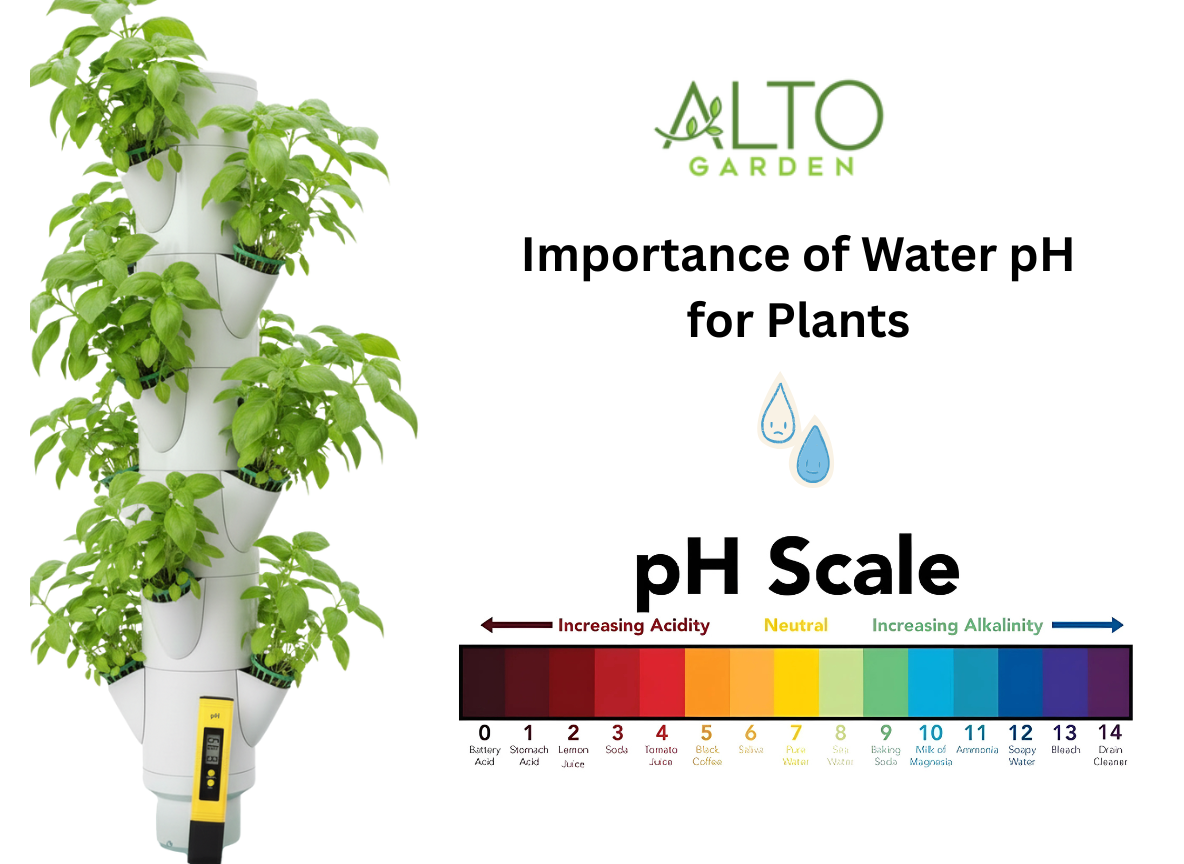Apr 10th 2024
Importance of Water pH for Plants
Drinking alkaline water has become more popular in recent years, with proponents saying that it provides more efficient hydration than regular water. Other claimed benefits include being able to neutralize acid in your bloodstream. That must be good right? Who wants acid in their bloodstream? Some even say drinking alkaline water can help prevent cancer and heart disease. Boy, this must be some serious stuff! Well, not really… all alkaline water is, is water with a pH measurement of greater than 7.
Now that you know about alkaline water, let’s talk about pH.

What Does pH Mean?
The letters “pH” stand for “potential of hydrogen.” Water for example, is comprised of hydrogen and oxygen atoms. Specifically – water is comprised two hydrogen atoms and one oxygen atom, which is why water is sometimes referred to as H2O. Without going too deep into the chemistry of it all, pH is basically a measurement of how the hydrogen of a liquid reacts, when dissolved in water. This reaction classifies the liquid in one of two buckets – acidity and alkalinity.
pH Scale Basics
The pH scale measures this reaction, on a scale of 1 – 14. Less than 7 means it’s acidic and greater than 7 means it’s alkaline. A measurement of 7 is considered neutral. Some examples of low pH would be lemon juice and vinegar (acidic). Examples of high pH would be ammonia and bleach (alkaline). Pure water would be neutral at a pH measurement of 7.
Why is pH Important for Plant Growth?
pH is important because plant nutrients, such as nitrogen and potassium, will not dissolve in water properly if the water pH is too acidic or alkaline. And if plant nutrients don’t dissolve in water properly, then the plants cannot absorb those nutrients. You want the water in your hydroponic system to be slightly acidic, at approximately 5.5 – 6.5 pH. This will allow your plants to have maximum uptake of the nutrients in the water.
How pH Affects Nutrient Uptake
- The pH of water and soil directly influences how readily nutrients dissolve and become available to plant roots.
- When pH is too high or low, some nutrients become “locked out”—present, but not accessible to plants.
- Extreme pH can make certain elements (like aluminum) too easily absorbed, leading to toxicity.
Symptoms of Incorrect pH in Plants
- Yellowing leaves (chlorosis) due to missed nutrients, like iron.
- Stunted growth and reduced quality.
- Root damage: short, stubby, or discolored roots.
Ideal Water pH Range for Plants
- Most plants thrive between pH 5.5–7.5; 6.0–7.0 is optimal for growth.
- Hydroponic systems: best at pH 5.5–6.5.
- Some plants (e.g., blueberries, azaleas, rhododendrons) prefer a more acidic pH. Others (lavender, lilac, yarrow) can tolerate slightly higher pH.
Maintaining the Right pH
- Regularly test your irrigation water’s pH weekly.
- Use pH test strips or a digital pH pen.
- Adjust pH with drops of pH Up or Down, or add natural acids (lemon juice, vinegar) or alkaline elements (crushed eggshells, wood ash) in small amounts.
Alkaline Water for Plants?
- Most common houseplants and garden vegetables prefer slightly acidic to neutral water (not alkaline!).
- Overuse of alkaline water can cause nutrient lockout, slow growth, or yellow leaves.

How to Measure and Adjust Water pH
Interestingly, water pH can fluctuate over time. You might measure your water at 5.5 today, but that same water measures at 6.5 next week. So it’s important to measure your water weekly, to make sure it’s within the optimal range. Measuring pH is easy. pH test strips can be used, where you dip the test strip in water and compare the resulting color of the test strip against the color chart provided with your test kit. You can also measure with a pH test pen by dipping the pen in water, and the pen will give you an instant reading like a thermometer. pH can be adjusted by adding a few drops of pH Up / Down to your water which will increase its alkalinity or acidity until you get to the right levels.
Growing Success With pH Maintenance
Growing healthy plants in your hydroponic tower is pretty easy with automated lighting and watering. But once a week – make sure to measure and maintain the pH levels in your water at the 5.5 – 6.5 range and your plants will thank you for it.
FAQs
- What pH should I maintain for hydroponic plants in my tower?
Most hydroponic plants thrive when the water pH is kept between 5.5 and 6.5 for optimal nutrient absorption. - Is alkaline water good for growing plants in a hydroponic tower?
Alkaline water (pH above 7) is generally not recommended for hydroponics, as it can cause nutrient lockout. Slightly acidic water is best for most plants. - How can I lower the water pH in my hydroponic system?
You can reduce water pH by adding small amounts of pH Down solution or safe acids like lemon juice or vinegar, testing as you go until the desired level is reached. - How do I know if water pH is causing problems for my plants?
Signs like yellowing leaves, stunted growth, or unhealthy roots may indicate your water pH is outside the recommended range and needs adjustment. - Why does water pH affect plant nutrient uptake in hydroponics?
Water pH controls how well essential nutrients dissolve and are absorbed by plant roots; incorrect pH can lead to deficiencies even if nutrients are present.




